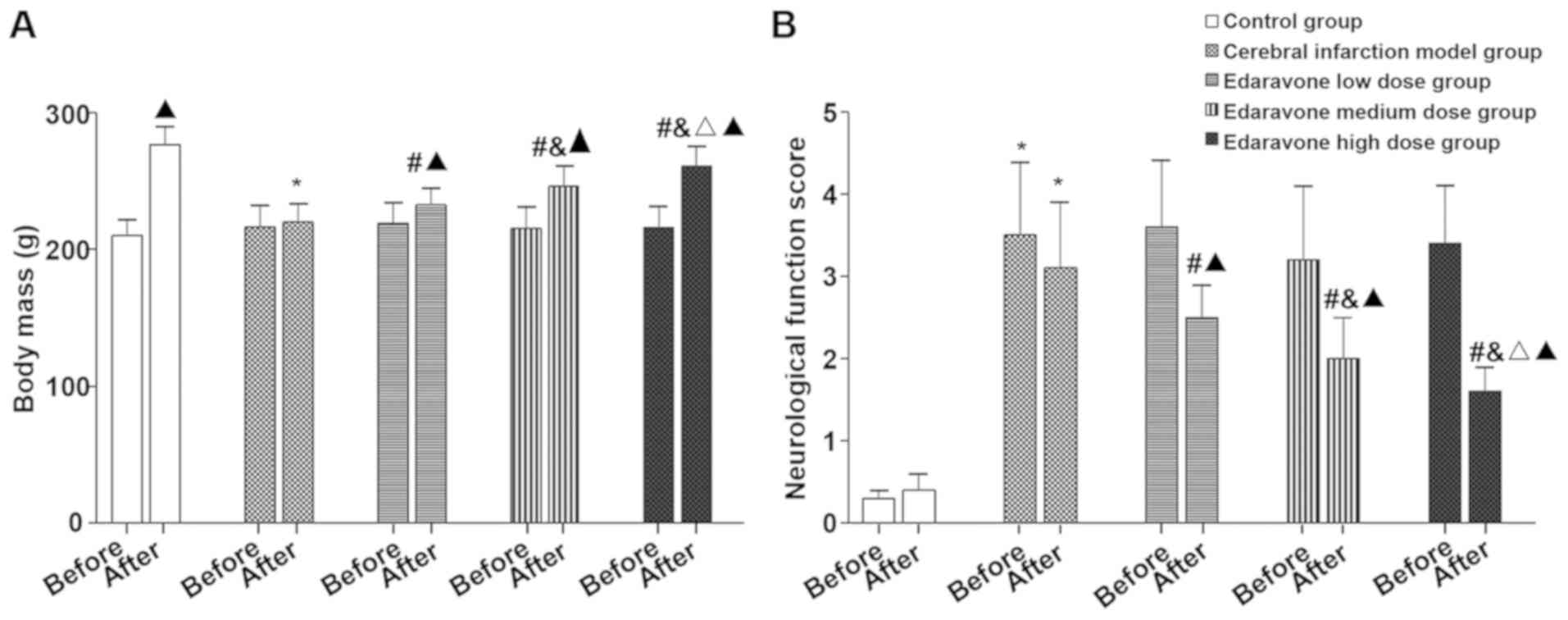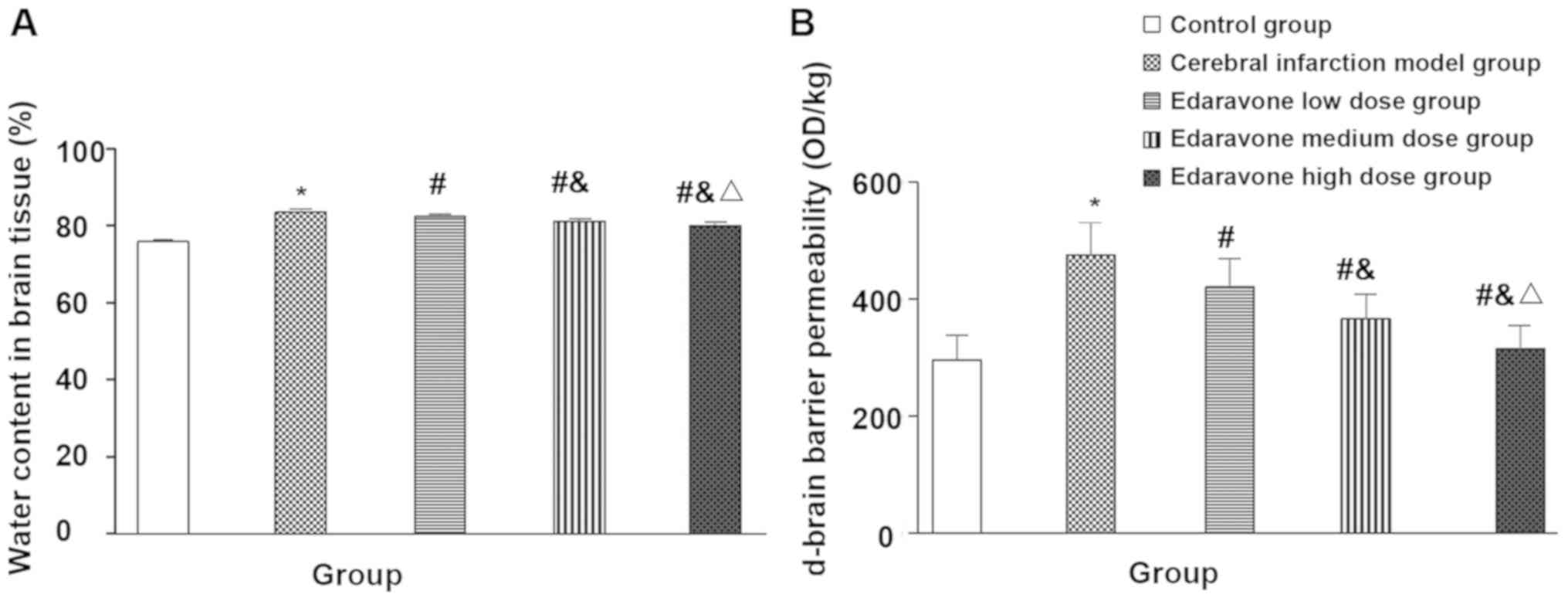|
1
|
Nagai N, Yoshioka C, Ito Y, Funakami Y,
Nishikawa H and Kawabata A: Intravenous administration of
cilostazol nanoparticles ameliorates acute ischemic stroke in a
cerebral ischemia/reperfusion-induced injury model. Int J Mol Sci.
16:29329–29344. 2015. View Article : Google Scholar : PubMed/NCBI
|
|
2
|
Chen S, Chen Z, Cui J, McCrary ML, Song H,
Mobashery S, Chang M and Gu Z: Early abrogation of gelatinase
activity extends the time window for tPA thrombolysis after embolic
focal cerebral ischemia in mice. eNeuro. 5(pii):
ENEURO.0391-17.2018. 2018.
|
|
3
|
Li M, Wen Y, Zhang R, Xie F, Zhang G and
Qin X: Adenoviral vector-induced silencing of RGMa attenuates
blood-brain barrier dysfunction in a rat model of MCAO/reperfusion.
Brain Res Bull. 142:54–62. 2018. View Article : Google Scholar : PubMed/NCBI
|
|
4
|
Liu X, Kiss GK, Mellender SJ, Weiss HR and
Chi OZ: Activation of Akt by SC79 decreased cerebral infarct in
early cerebral ischemia-reperfusion despite increased BBB
disruption. Neurosci Lett. 681:78–82. 2018. View Article : Google Scholar : PubMed/NCBI
|
|
5
|
Liu C, Zhong L, Tian XL and Han YC:
Protective effects of 8-MOP on blood-brain barrier via the
Nrf-2/HO-1 pathway in mice model of cerebral infarction. Eur Rev
Med Pharmacol Sci. 22:4278–4287. 2018.PubMed/NCBI
|
|
6
|
Liu Z, Ma C, Shen J, Wang D, Hao J and Hu
Z: SDF-1/CXCR4 axis induces apoptosis of human degenerative nucleus
pulposus cells via the NF-κB pathway. Mol Med Rep. 14:783–789.
2016. View Article : Google Scholar : PubMed/NCBI
|
|
7
|
Yamada H, Kikuchi R, Nakamura A and
Miyazaki H: Severe reversible cerebral vasoconstriction syndrome
with large posterior cerebral infarction. J Stroke Cerebrovasc Dis.
27:3043–3045. 2018. View Article : Google Scholar : PubMed/NCBI
|
|
8
|
Ohta Y, Takamatsu K, Fukushima T, Ikegami
S, Takeda I, Ota T, Goto K and Abe K: Efficacy of the free radical
scavenger, edaravone, for motor palsy of acute lacunar infarction.
Intern Med. 48:593–596. 2009. View Article : Google Scholar : PubMed/NCBI
|
|
9
|
Chen Y and Zhao Y: Curative efficacy of
penehyclidine combined with edaravone on acute cerebral infarction
and their effects on serum TNF-α and NDS score in rats. Eur Rev Med
Pharmacol Sci. 22:223–228. 2018.PubMed/NCBI
|
|
10
|
Tóth AE, Walter FR, Bocsik A, Sántha P,
Veszelka S, Nagy L, Puskás LG, Couraud PO, Takata F, Dohgu S, et
al: Edaravone protects against methylglyoxal-induced barrier damage
in human brain endothelial cells. PLoS One. 9:e1001522014.
View Article : Google Scholar : PubMed/NCBI
|
|
11
|
Niu F, Song XY, Hu JF, Zuo W, Kong LL,
Wang XF, Han N and Chen NH: IMM-H004, A new coumarin derivative,
improved focal cerebral ischemia via blood-brain barrier protection
in rats. J Stroke Cerebrovasc Dis. 26:2065–2073. 2017. View Article : Google Scholar : PubMed/NCBI
|
|
12
|
Tsuruoka A, Atsumi C, Mizukami H, Imai T,
Hagiwara Y and Hasegawa Y: Effects of edaravone, a free radical
scavenger, on circulating levels of MMP-9 and hemorrhagic
transformation in patients with intravenous thrombolysis using
low-dose alteplase. J Stroke Cerebrovasc Dis. 23:2894–2899. 2014.
View Article : Google Scholar : PubMed/NCBI
|
|
13
|
Li C, Wang R, Hu C, Wang H, Ma Q, Chen S
and He Y: Pyridoxine exerts antioxidant effects in cell model of
Alzheimer's disease via the Nrf-2/HO-1 pathway. Cell Mol Biol.
64:119–124. 2018. View Article : Google Scholar : PubMed/NCBI
|
|
14
|
Wang W, Wang X, Zhang XS and Liang CZ:
Cryptotanshinone attenuates oxidative stress and inflammation
through the regulation of Nrf-2 and NF-κB in mice with unilateral
ureteral obstruction. Basic Clin Pharmacol Toxicol. 123:714–720.
2018. View Article : Google Scholar : PubMed/NCBI
|
|
15
|
Liu X, Zhang X, Ma K, Zhang R, Hou P, Sun
B, Yuan S, Wang Z and Liu Z: Matrine alleviates early brain injury
after experimental subarachnoid hemorrhage in rats: Possible
involvement of PI3K/Akt-mediated NF-κB inhibition and
Keap1/Nrf2-dependent HO-1 inductionn. Cell Mol Biol
(Noisy-le-grand). 62:38–44. 2016.PubMed/NCBI
|
|
16
|
Liu Z, Yang C, Meng X, Li Z, Lv C and Cao
P: Neuroprotection of edaravone on the hippocampus of
kainate-induced epilepsy rats through Nrf2/HO-1 pathway. Neurochem
Int. 112:159–165. 2018. View Article : Google Scholar : PubMed/NCBI
|
|
17
|
Zhang D, Xiao Y, Lv P, Teng Z, Dong Y, Qi
Q and Liu Z: Edaravone attenuates oxidative stress induced by
chronic cerebral hypoperfusion injury: Role of ERK/Nrf2/HO-1
signaling pathway. Neurol Res. 40:1–10. 2018. View Article : Google Scholar : PubMed/NCBI
|
|
18
|
Cechetti F, Worm PV, Elsner VR, Bertoldi
K, Sanches E, Ben J, Siqueira IR and Netto CA: Forced treadmill
exercise prevents oxidative stress and memory deficits following
chronic cerebral hypoperfusion in the rat. Neurobiol Learn Mem.
97:90–96. 2012. View Article : Google Scholar : PubMed/NCBI
|


















